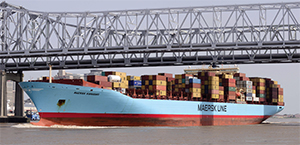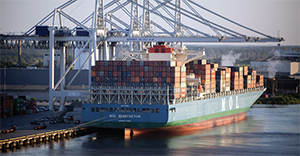The “neo-Panamax” era officially began on June 26 when COSCO Shipping Panama passed through the Panama Canal’s new Agua Clara locks built to accommodate larger ships.
Within two weeks, ships that sailed through the wider, deeper canal system began calling at major East Coast ports, including Miami, Charleston, Norfolk and New York-New Jersey. The 10,000-TEU MOL Benefactor was the largest vessel ever to serve Savannah, according to the Georgia Ports Authority.
The 48-mile Panama Canal is a marvel of modern engineering that has facilitated travel and trade between the East and West since it opened in 1914. The $5.4 billion Agua Clara locks will accommodate ships up to 1,200 feet long carrying about 13,000 TEU. The existing Gatun locks are limited to ships carrying roughly 5,000 TEU.
Major ports from the Gulf of Mexico to New England have spent the past decade preparing for the new locks to open. Federal, state and local governments have spent billions of dollars on dredging, cargo cranes and other infrastructure upgrades to compete for larger ships and potentially higher volumes.
The Panama Canal Authority considers the new locks a “game changer” for world trade, but some experts expect that impacts will be relatively muted, at least in the short term.
David Egan, head of industrial and logistics research in the Americas for the commercial real estate giant CBRE, said some cargo volumes will shift to the East Coast. However, he said this shift has been occurring for some time, leaving less room for growth.
In 2007, when the expansion project began, Egan said roughly 60 percent of U.S. cargo moved through the West Coast, while East Coast and Gulf of Mexico ports moved the remaining 40 percent. Yet in the past nine years, eastern ports have increased their share to about 48 percent.
“Where we’re going to end up is about 50-50,” Egan said in a recent interview. “There is a pretty profound shift underway, and we’ve been getting close to that 50-50 balance even without the new locks.”
The need for more distribution hubs closer to East Coast population centers is the biggest driver of that shift, he said. Sporadic labor issues at West Coast ports also convinced some shippers to diversify cargo destinations.
Longer term, as manufacturing moves westward from China to other countries, Egan believes an even larger share of cargo will move through the East Coast. India and Africa, for instance, are much closer to the Eastern Seaboard.
West Coast ports are paying attention to possible shifts eastward in cargo. Phillip Sanfield, spokesman for the Port of Los Angeles, referenced a 2015 Boston Consulting Group study predicting that up to 10 percent of cargoes from Asia could move from West to East Coast ports. However, the study notes that the actual impact likely will be less than that. One reason is the longer transit time from Asia to East Coast ports. Passing through the Panama Canal can add up to 10 days to the voyage.
“At the end of the day, there may be some diversions … but we just have to watch over the next couple years to see where it goes,” he said. “Meantime, the Port of Los Angeles continues to build out its infrastructure to bring in megaships beyond 14,000 TEUs.”
Peter McGraw, spokesman for the Northwest Seaport Alliance representing the ports of Seattle and Tacoma, Wash., said officials there are keeping a close eye on potential impacts from the new locks.
 |
|
The neo-Panamax Maersk Kawasaki transits the Mississippi River in New Orleans. The port says it is “big-ship ready” and can accommodate up to 10,000 TEUs. |
|
Photo courtesy Port of New Orleans |
Despite the fanfare, the Agua Clara project has faced scrutiny about its overall design and size. There are concerns about the tugboats that escort ships through the locks, and that the locks leave little margin for error during windy transits. In July, the China COSCO Shipping vessel Xin Fei Zhou sustained hull damage after bumping a wall in the new locks. That accident appears to be an anomaly, however: According to the Panama Canal Authority, 55 ships transited the new locks in the first month, with damage to Xin Fei Zhou being the only reported incident.
East Coast ports drawing neo-Panamax ships have touted their arrival and the ports’ readiness to handle bigger ships and higher cargo volumes.
“The Port of New Orleans is well-positioned to accommodate the more than doubling of volumes,” said port President and CEO Gary LaGrange in a prepared statement. “We are big-ship ready and can handle up to 10,000-TEU ships currently.”
Meanwhile, the Port of Savannah has ordered eight neo-Panamax cranes and is dredging to deepen the inner harbor to 47 feet and the outer harbor to 49 feet to accommodate bigger ships.
“Over the next six months to a year, we expect a higher ratio of 8,000- to 10,000-TEU containerships among our vessel calls,” Griff Lynch, executive director of the Georgia Ports Authority, said in a prepared statement. “Within two years, we expect market shifts to send 12,000-TEU vessels to the U.S. East Coast.”
The Port of New York and New Jersey has spent nearly $6 billion in the past decade upgrading its facilities. These improvements include dredging the channel to 50 feet, raising the roadbed on the Bayonne Bridge to allow larger ships into its terminals, and myriad portside road and rail improvements.
“The new Panama Canal now allows ships as large as 14,000 TEUs to call on the Port of New York and New Jersey,” said Lenis Rodrigues, a port spokeswoman.
Tugboat companies and harbor pilots in these ports are prepared to handle larger ships.
Hays Clark, vice president and general manager of Crescent Towing’s Savannah operation, said the company’s tugs regularly escort ships with up to 9,000 TEU that travel through the Suez Canal. The 10,000-TEU MOL Benefactor that recently called on Savannah required greater tug utilization for escort, turning and docking maneuvers, he said.
Other vessels of similar size also have called on Savannah since the new locks opened. Even so, Clark said it’s too soon to know how the new locks will affect the port and the company in the long term.
Capt. John Cameron, executive director of the Charleston Pilots in Charleston, S.C., said in a single day this summer the port handled three ships larger than 8,000 TEU and one 9,000-TEU ship. Charleston Pilots has run simulations on ships up to 14,000 TEU and will be ready once those ships start arriving.
“We’ve had so many inquiries and discussions that I just have to believe it’s only a matter of time before one of the lines begins deploying ships of that class here,” he said. “That seems to be the class that could be the workhorse of many of the trade routes into the East Coast.”

